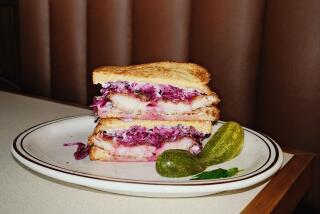This Article Also Comes in Peanut Butter-Peppermint
- Share via
Standing at the counter of the local bagel store, confronted by an impressive set of choices in filling out my baker’s dozen, I was struck by a developing trend in food retailing. With more than 16 varieties in bins labeled everything from poppy dip’d to nutty banana, sun-dried tomato to chocolate chip, the world of bagels seemed to be reaching far beyond its original ethnic context into the once-separate realms of other kinds of comestibles.
If this phenomenon were limited to Jewish breakfast rolls, it might not be alarming. But virtually every kind of food is undergoing a flavor-creep so extreme that it is becoming difficult to distinguish between pasta and coffee, yogurt and cookies, on the basis of taste.
There was a time when a bagel was a bagel and a pizza was a pizza, but now we can get pizzels: pizzas made on flattened bagel dough. Before you can order one of these intercultural snacks, however, you’ll have to choose between varieties: the Italian (with mozzarella and tomato sauce), the Greek (feta and olives), the Mexican (salsa and beans) and the Japanese (teriyaki chicken).
To wash down your meal, there’s no need to choose either soda or juice, since New Age spritzers come in flavors once reserved for juices, including lemonade, mango-orange and peach. Or grab a cup of coffee, and face a decision: hazelnut mocha, vanilla bean or raspberry chocolate? For desert, perhaps a chocolate chip, or peanut butter chip or butterscotch chip cookie.
A look around the supermarket suggests the power of this trend. Once there was yogurt: plain, wholesome, sour and smooth, a foodstuff proud of its identity. Today, a fully varietized industry shouts choice in dozens of refined flavors: French vanilla and vanilla bean, mocha and cappuccino, lemon chiffon and lemon meringue. The same process has invaded pasta, the once-white foodstuff that now comes in scores of flavors with nuanced color options to match: lemon pepper and red pepper, spinach green and basil green, tomato and spicy tomato.
Snack foods like popcorn, chips and jelly beans were among the first varietized edibles, but in the past year or two the trend has overtaken that staple among staples, the American hamburger. It’s now available as buffalo burger, chicken burger, turkey burger, fish burger, salmon burger, harvest burger, veggie burger, okra burger, ad infinitum.
Some will see nothing ominous in a trend that seems to be increasing our options, allowing us to have it our way. The problem, however, is the inverse relation between flavor-creep and the preservation of simple and distinct foods. If we truly are what we eat, we should at least pause to reflect on where we may be heading.
One possibility became frighteningly clear to me as I stood at the bagel counter agonizing over the last choice for my bag: cinnamon swirl or cinnamon sugar? Gazing at the wall of bins divided by flavor, I heard an employee call out, “Fresh everythings--hot from the oven.”
The everything bagel, it turns out, combines many of the flavors available separately. In its multiplicity, its colonization of options, it may be a foray into the future--a world in which the ubiquitous 27 flavors will be combined into one. They won’t call it “Soylent Green,” but it will probably taste like everything and nothing and provoke a movement back to the days when yogurt was yogurt and a cup of coffee was just a drink called Joe.
More to Read
Eat your way across L.A.
Get our weekly Tasting Notes newsletter for reviews, news and more.
You may occasionally receive promotional content from the Los Angeles Times.










